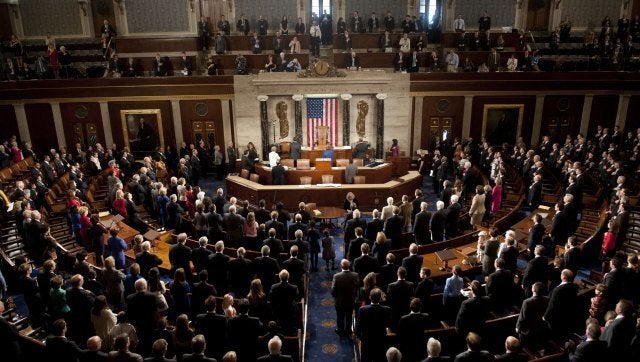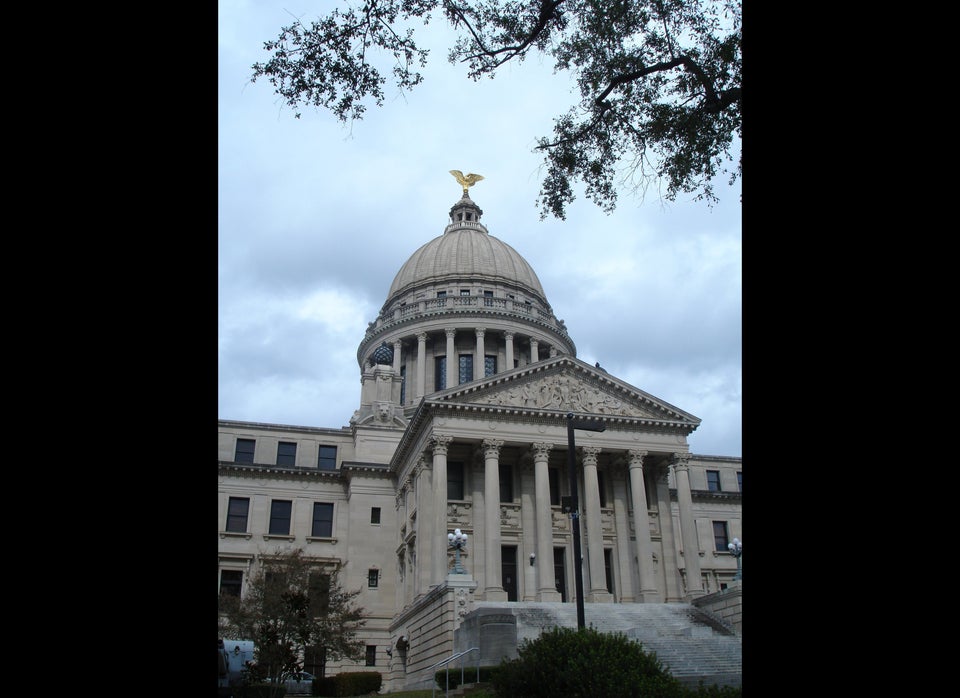
Nearly one-in-five Americans have no religion, but only one member of the 533 people in the new 113th Congress that was sworn in Thursday would fall into one of the largest and fastest growing American demographics when it comes to religion or lack thereof.
A new analysis from the Pew Forum shows that while the new Congress is more diverse than ever before -- it includes the the nation's first Buddhist Senator and the first Hindu in either chamber of Congress, for example -- it's still far less diverse than the nation it represents.
Like the one before it, the new Congress is majority Protestant, but its changing membership is part of a "gradual increase in religious diversity that mirrors trends in the country as a whole," according to the Pew analysis. Congress is "far less" Protestant today than it was 50 years ago, when almost three-quarters of its membership was Protestant, according to the analysis.
"Protestants, Catholics, Jews and Mormons each make up a greater percentage of the members of Congress than of all U.S. adults. The same is true for some subgroups of Protestants, such as Episcopalians and Presbyterians. By contrast, Pentecostals are a much smaller percentage of Congress than of the general public," the analysis says. "Due in part to electoral gains in recent years, Buddhists, Muslims and Hindus now are represented in Congress in closer proportion to their numbers in the U.S. adult population. But some small religious groups, such as Jehovah’s Witnesses, are not represented at all in Congress."
Pew says that "perhaps greatest disparity, however, is between the percentage of U.S. adults and the percentage of members of Congress who do not identify with any particular religion." One-in-five U.S. adults are atheist, agnostic or "nothing in particular," a group that's altogether often called the "nones." But only one person in the 113th Congress, Rep. Kyrsten Sinema (D-Ariz.), does not affiliate with any particular religion, though Sinema has also said through a spokesman that "the terms non-theist, atheist or non-believer are not befitting of her life's work or personal character."
In addition to Sinema, ten other members of the new Congress (about two percent) don't specify their religion, an increase from six members (about one percent) in the previous Congress. According to Pew, that two percent figure is the same as the share of U.S. adults who have said in surveys that they don’t know or will not specify their religion.
The religious group to have the biggest increase in Congressional membership is Catholics, who have gained seven seats for a total of 163, making just above 30 percent of Congress Catholic. The biggest declines in numbers are among Jews and Protestants. Jews now have 33 seats in Congress (six percent), which is six fewer than before. Protestants lost eight seats, but they the current Congress has nearly the same percentage of Protestants (56 percent) as the previous one (57 percent).
The share of Protestants in each party remains nearly the same, too, as the 112th Congress. About seven-in-ten Republicans are Protestants, while less than half of Democrats are. But members of Congress who were sworn in for the first time on Thursday are significantly less Protestant than the Congressional freshmen class of 2011. Forty-eight percent of this year's freshmen class are Protestant, compared to 59 percent of the freshmen class two years ago.
Mormons have 15 seats (about three percent) in the new Congress, the same number as in the previous Congress.


From Pew:
Hawaii Democrat Tulsi Gabbard is the first Hindu in either the House of Representatives or the Senate. Gabbard, an Iraq War veteran who has served on the Honolulu City Council and in the Hawaii state legislature, represents Hawaii’s 2nd congressional district. Gabbard takes over the seat held in the 112th Congress by Rep. Mazie K. Hirono (D), who on Nov. 6, 2012, became the first Buddhist elected to the Senate.In 2006, Hirono and Rep. Hank Johnson (D-Ga.) became the first Buddhists to be elected to the House. Four years later, they were joined by a third Buddhist member, Colleen Hanabusa (D-Hawaii). Johnson and Hanabusa were re-elected to serve in the 113th Congress.
The first Muslim to serve in either the House or the Senate, Rep. Keith Ellison (D-Minn.), was elected in 2006. Rep. Andre Carson (D-Ind.) became the second Muslim in Congress when he won a special election in 2008. In 2012, Michigan Democrat Syed Taj lost his bid to become the third Muslim member of Congress. Ellison and Carson were re-elected.
Members of other small religious groups started serving in Congress more than a century ago. The first Jewish member arrived in 1845, when Lewis Charles Levin of the American Party began representing Pennsylvania in the House. The first Mormon in Congress, John Milton Bernhisel, began serving in 1851, after Utah was officially recognized as a territory. California Democrat Dalip Singh Saund, the first and so far only Sikh to serve in Congress, served three terms starting in 1957.
Rep. Pete Stark (D-Calif.), a Unitarian who joined Congress in 1973, became the first member of Congress to publicly declare, in 2007, that he does not believe in a Supreme Being. He lost his re-election bid in 2012.
Of the 533 members of the new Congress, 299 are Protestant, which is about the same percentage (56 percent) as in the 112th Congress (57 percent) and higher than the share of Protestants in the U.S. adult population (48 percent). But the proportion of Protestants in Congress has been in gradual decline for decades, and the number in the 113th Congress is lower than the number in the previous Congress (307), even if the difference in percentage terms is slight.



From Pew:
In many ways, the changes in the religious makeup of Congress during the last half-century mirror broader changes in American society. Congress, like the nation as a whole, has become much less Protestant and more religiously diverse. The number of Protestants in Congress has dropped from three-quarters (75 percent) in 1961 to 56 percent today, which roughly tracks with broader religious demographic trends during this period. As recently as the 1980s, General Social Surveys found that about six-in-ten Americans identified themselves as Protestants. In aggregated surveys conducted by the Pew Research Center in 2012 and reported in the Pew Forum’s October 2012 report “‘Nones’ on the Rise,” the share of self-identified Protestants has dipped to just under half (48 percent).Likewise, many of the major Protestant denominational families have lost ground in Congress in the past 50 years. Methodists, who made up nearly one-in-five members (18 percent) of the 87th Congress, which was seated in 1961, make up nine percent of the 113th Congress. Some other Protestant denominational families also have seen a decline in their numerical representation in Congress. For example, Episcopalians have gone from 12 percent to seven percent and Congregationalists from five percent to less than one percent during this period.
A few Protestant groups have fared somewhat better, however. From 1961 to today, the proportion of Baptists in Congress has increased slightly from 12 percent to 14 percent, and the Lutheran share has stayed roughly the same (around four percent).
Meanwhile, other religious groups have seen their share of congressional seats grow, in some cases dramatically. Catholics, for instance, have gone from 19 percent of the congressional membership in 1961 to 31 percent today. The percentage of Jewish members of Congress has risen from two percent in 1961 to six percent today.


